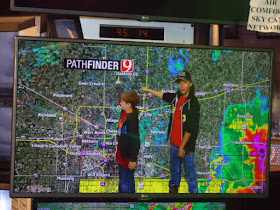We learned about the various departments at the news station, and how each works together to put out the daily broadcast. There are so many different elements, and just about every type of talent is needed at the station!
The chopper pilot explained to us about helicopters and how they are used for breaking news and weather coverage. My little one thinks that this guy hung the moon, so it was the highlight of his day. After leaving the hangar, we headed in for the lunchtime news.
We saw the anchor filming various commercials, and then had a chance to ask questions. The kids had an opportunity to role play at various stations, but one of the favorites was getting to be the weatherman. Here, we are watching them explain that the storms have passed the city and are currently pummeling our house! All in all, it was a fantastic day, and it really got the kids involved in learning about journalism.
Journalism Unit
- How to Watch TV News
- Earthquake in the Early Morning
- Popcorn at the Palace & lapbook
- Elementary workshop
- Middle Grades workshop
- High School project
SchoolhouseTeachers has a fantastic unit on studying the news with discernment! Reading the News is a reading instruction program that uses Associated Press news articles for reading material. The program is appropriate for middle school through adult students, and employs specific learning strategies that improve students’ reading and spelling abilities. The learning strategies focus on repeated reading, timed reading, vocabulary, and comprehension. The strategies are built into audio learning and workbooks. The program challenges students to read at higher levels. They make progress in reading and develop the real-life skill of newspaper reading.

Student Newspaper Challenge
- Learn how the news is portrayed from various sources. Read a local newspaper, a national newspaper, a news magazine, and an online news source. From each of these, clip stories about the same event. Analyze the clips, comparing the different stories, explaining how the stories are objective or subjective and how each publication handled the story differently, depending on its purpose or audience.
- Pinpoint your stories. Pick three to six stories that are related to your family / homeschool, and think about what angle you would like to use. (Gunning for a new Lego set? Why not write an editorial explaining how you will earn the money?)
- Prepare a front-page newspaper layout. Edit, copy, proofread a story after it has been typeset , and be able to explain the printing process.
- Help visualize the stories. Using a camera, take pictures to illustrate your stories. Take a series of photographs that would help to tell a story in pictures, including some news photos and some feature photos. Write cutlines for your photos and a brief story of the event. Edit them with Canva or PicMonkey, and insert them into your paper.
Give your children a
fresh start this year with the refreshing change of home education and
purchase a SchoolhouseTeachers.com membership today! Use code: START139 to
pay only $139/yr or code: START16 to pay only $16/mo. New members located in the US and Canada will
also receive a beautiful Mama Bear tote with their Fresh
Start sale purchase (publisher’s choice, while supplies last)!
Pick up a printable copy of this unit in the Humanities Unit Study Bundle!
- Each unit has introductory text, which will give the student basic background information about the topic at hand.
- There are photographs and illustrations, and we have also included primary documents when available.
- After this text, there are featured videos, which augment the background information and help make the topic more accessible for more visual students.
- You will also find a short list of reading books.
- There are vocabulary words, places, and people to identify.
- Reading comprehension, critical thinking questions, and writing assignments are included.
- We add fun with hands-on activities and extra videos to watch that will bring the era to life.
- Some units also have cooking projects.
These studies are directed toward upper grades students, but some have resources for younger students so that the whole family can work together. Our family has used unit studies as curriculum for many years, and we hope that your family will enjoy these, too!










No comments:
Post a Comment
Note: Only a member of this blog may post a comment.